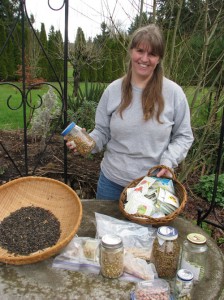Pam Milliren has an addiction.
“I started seed saving because of my dad,” Milliren said. “It became a wonderful obsession. I now have at least 571 types.”
Hundreds of jars, envelopes and various other containers attest to her mission of perpetuating strains of open pollinated vegetables, herbs, flowers and fruit that may otherwise fade out of existence.
When she moved to back to Oregon from upper British Columbia in late 2009 she brought them and her annual seed-sharing event, “Seedy Saturday.”
“I feel it is important to preserve them as so many are lost,” Milliren said. “There are very few people out there raising them.”
Many of the varieties she has collected date back a good 50 to 300 years – some may go back 1,000 years.
“Quite a few were given to me by the family descendants, such as the Bob Campbell family of Ontario who have had a red, pink and white hollyhock growing on the family farm since the 1800s,” she said.
Keeping seeds is becoming a forcibly lost art.
Community members are
invited to come swap seeds,
especially heirloom varieties or
those that have been in the
family for years.
Saturday, March 5,
9 a.m. – 4 p.m.
Silverton Grange Hall,
201 Division St.
“Prior to the 1950s, most seed was open pollinated; then seed houses began hybridizing them, keeping their “parents” a secret so that customers could not save seed and had to go back to the company to get their favorite varieties,” she said.
Then came the 1970s and the advent of GMOs (Genetically Modified Organisms) that quickly became a major agri-business. Chosen DNA molecules from different sources are combined into one, which is then transferred into an organism, giving it modified or novel genes.
“So it is even more important that there are people who save seeds,” Milliren said.
Her collection includes ‘Pony peas,’ colored like pinto horses; black, purple, red and yellow sunflowers; pre-15th Century apples, pears – and medlars. It bears fruit resembling “big fat rose hips that have to rot to be edible.” This ripening, known as bletting, is accomplished by storing them for weeks. At that time the fruit becomes soft, mushy brown, sweet and tasty, quite like cinnamon applesauce – a fresh fruit for wintertime consumption.
While most gardeners derive their enjoyment from the plants, Milliren is keener on each seed’s beauty and individuality. She grows heirloom plants and savors their fruit, but for her, the real harvest comes as she scrupulously collects and preserves those tiny gems harboring the germ of life.
Exchanging seeds is a safeguard – and a way of developing strains custom-made for a given region. Over time, a species will adapt its environment; its seasons, temperatures, soil, diseases, pests and more.
Milliren procured landraces able to survive – and thrive – in her region of Canada with its swinging high and low temps and short growing season – ‘Iron Creek Annie’ bean; ‘Red Horn Apple’ carrot; and ‘Siberian’ kale – vegetables that probably wouldn’t make there if not acclimatized.
If one saver has a crop failure, because of the network of seed-saving folk, there’s bound to be someone – even on the other side of the country – glad to replenish their supply.
Milliren has also raised heritage sheep, chickens and turkeys. She tells of the “seriously ancient” White Park cattle.
“White cattle with colored points are first mentioned in old Irish sagas dating back almost 2,000 years,” she said. “Blood typing has established that the White Park is genetically far distant from all British breeds.”
This affinity with bygone days also plays out in Milliren’s long-time involvement in medieval reenactments, where dying arts live again: blacksmithing, book illumination, cloth dyeing, archery, pewter casting – and where cabbages and beans from the Middle Ages may be found. She’s also an avid hiker.
Although she moved from 40 acres to a half acre, her gardens, now consuming a modest yard, manage to produce a plethora of heirloom seeds. Though she’s a single mother with a baby, Milliren composts two to three pounds of material a day.
She shares what she knows, including some great home remedies and growing tips, through the magazine she started in 1995. “Down to the Roots,” has made its way into 10 countries, solely by word of mouth. It features back-to-basics green living, homesteading and step-by-step projects.
But the crème de la crème are seeds, seeds, seeds to be swapped and shared – and a slideshow on how and why it’s such a good idea.
